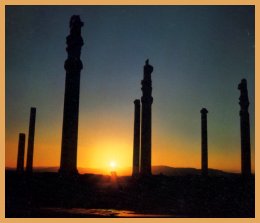 |
The Festival of "Yalda" (Winter Solstice Celebrations)
"A view of the ruins of Apadana (audience hall), Persepolis" The winter solstice, December 21st or 22nd, is the longest night of the year. For example, this year, on 21st December London (England) will see only seven hours and 49 minutes of daylight. Near the winter solstice, the length of the day changes very slowly, as does the Sun's height in the sky - one of the reasons why the long winter nights seem to go on forever! In Iran, the winter solstice has been celebrated for centuries and it is called Shab-e yalda, which refers to the birthday or rebirth of the sun. Yalda is a Syriac word and means birth (tavalod and meelaad are from the same origin). The ceremony is traced to the primal concept of Light and Good against Darkness and Evil in the ancient Iranian religion. This night with Evil at its zenith is considered unlucky. The last day of the Persian month of 'Azar' is the longest night of the year. From this day forward, Light triumphs as the days grow longer and give more light. This celebration comes in the Persian month of 'Day', which was also the name of the pre-Zoroastrian creator god (deity). Later he became known as the God of creation and Light, from which we have the English word day (the period of light in 24 hours). The Persians adopted their annual renewal festival from the Babylonians and incorporated it into the rituals of their own Zoroastrian religion. The occasion was celebrated in the festival of 'Daygan' dedicated to Ahura Mazda, the Lord of Wisdom. Fires would be burnt all night to ensure the defeat of the forces of Ahriman (principle Evil). There would be feasts, acts of charity and a number of deities honoured and prayers performed to ensure the total victory of the sun that was essential for the protection of winter crops. There would be prayers to Mithra (Mehr) and feasts in his honour, since Mithra is the Eyzad (deity) responsible for protecting " the early morning light", known as 'Havangah'. It was also assumed that Ahura Mazda would grant people's wishes. Early Christians took this very ancient Persian celebration and linked it to Christ's birthday. Today, the date for Christmas has slightly changed, but there are many similarities such as, lighting candles, decorating trees with lights, staying up all night, singing and dancing, eating special foods, paying visits to family and friends, ... Traditions: In the evening of Shab-e Yalda bonfires are lit outside, while inside the home, family and friends gather in a night-long vigil around the korsi, a low, square table covered with a thick cloth overhanging on all sides. A brazier with hot coals is placed under the table. In the past, fruit and vegetables were only available in season and the host, usually the oldest in the family, would have carefully saved grapes, honeydew melons, watermelons, pears, oranges, tangerines, apples, and cucumbers. These were then enjoyed by everyone gathered around the korsi, or a fireplace. On this night, the oldest member of the family says prayers, thanking God for previous year's blessings, and prays for prosperity in the coming year. Then he cuts the melon, and the watermelon and gives everyone a share. The cutting symbolizes the removal of sickness and pain from the family. Snacks are passed around throughout the night: pomegranates with angelica powder (gol-par) and Ajil-e shab-e yalda, a combination of nuts and dried fruits, particularly pumpkin and watermelon seeds and raisins. This mixture of nuts literally means night-grazing; eating nuts is said to lead to prosperity in days to come. More substantial fare for the night's feast include eggplant stew with plain saffron-flavored rice, rice with chicken, thick yogurt, and halva (saffron and carrot brownies). The foods themselves symbolize the balance of the seasons: watermelons and yogurt are eaten as a remedy for the heat of the summer, since these fruits are considered cold, or sardi; and halva is eaten to overcome the cold temperatures of winter, since it is considered hot, or garmi. On into the night of festivities the family keeps the fires burning and the lights glowing to help the sun in its battle against darkness. They recite poetry and play music, tell jokes and stories, until the sun, triumphantly reappears in the morning.
Copyright shall at all times remain vested in the Author. No part of the work shall be used, reproduced, stored in a retrieval system, or transmitted in any form or by any means electronic, mechanical, photocopying, recording or otherwise, without the Author's express written consent. Copyright © 1999, 2000, 2001, 2002, 2003, 2004 K. Kianush, Art Arena |
